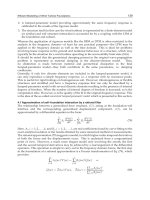Chapter 102. Aplastic Anemia, Myelodysplasia, and Related Bone Marrow Failure Syndromes (Part 6) ppt
Bạn đang xem bản rút gọn của tài liệu. Xem và tải ngay bản đầy đủ của tài liệu tại đây (43.74 KB, 5 trang )
Chapter 102. Aplastic Anemia, Myelodysplasia, and
Related Bone Marrow Failure Syndromes
(Part 6)
Immune-Mediated Injury
The recovery of marrow function in some patients prepared for bone
marrow transplantation with antilymphocyte globulin (ALG) first suggested that
aplastic anemia might be immune-mediated. Consistent with this hypothesis was
the frequent failure of simple bone marrow transplantation from a syngeneic twin,
without conditioning cytotoxic chemotherapy, which also argued both against
simple stem cell absence as the cause and for the presence of a host factor
producing marrow failure.
Laboratory data support an important role for the immune system in
aplastic anemia. Blood and bone marrow cells of patients can suppress normal
hematopoietic progenitor cell growth, and removal of T cells from aplastic anemia
bone marrow improves colony formation in vitro.
Increased numbers of activated cytotoxic T cells are observed in aplastic
anemia patients and usually decline with successful immunosuppressive therapy;
cytokine measurements show a T
H
1 immune response (interferon γ and tumor
necrosis factor).
Interferon and tumor necrosis factor induce Fas expression on CD34 cells,
leading to apoptotic cell death; localization of activated T cells to bone marrow
and local production of their soluble factors are probably important in stem cell
destruction.
Early immune system events in aplastic anemia are not well understood.
Analysis of T cell receptor expression suggests an oligoclonal, antigen-driven
cytotoxic T cell response. Many different exogenous antigens appear capable of
initiating a pathologic immune response, but at least some of the T cells may
recognize true self-antigens.
The rarity of aplastic anemia despite common exposures (medicines,
hepatitis virus) suggests that genetically determined features of the immune
response can convert a normal physiologic response into a sustained abnormal
autoimmune process, including polymorphisms in histocompatibility antigens,
cytokine genes, and genes that regulate T cell polarization and effector function.
Clinical Features
History
Aplastic anemia can appear with seeming abruptness or have a more
insidious onset. Bleeding is the most common early symptom; a complaint of days
to weeks of easy bruising, oozing from the gums, nose bleeds, heavy menstrual
flow, and sometimes petechiae will have been noticed.
With thrombocytopenia, massive hemorrhage is unusual, but small
amounts of bleeding in the central nervous system can result in catastrophic
intracranial or retinal hemorrhage.
Symptoms of anemia are also frequent, including lassitude, weakness,
shortness of breath, and a pounding sensation in the ears. Infection is an unusual
first symptom in aplastic anemia (unlike in agranulocytosis, where pharyngitis,
anorectal infection, or frank sepsis occur early).
A striking feature of aplastic anemia is the restriction of symptoms to the
hematologic system, and patients often feel and look remarkably well despite
drastically reduced blood counts.
Systemic complaints and weight loss should point to other etiologies of
pancytopenia. Prior drug use, chemical exposure, and preceding viral illnesses
must often be elicited with repeated questioning. A family history of hematologic
diseases or blood abnormalities may indicate a constitutional etiology of marrow
failure.
Physical Examination
Petechiae and ecchymoses are typical, and retinal hemorrhages may be
present. Pelvic and rectal examinations can often be deferred but, when performed,
should be undertaken with great gentleness to avoid trauma; these will often show
bleeding from the cervical os and blood in the stool. Pallor of the skin and mucous
membranes is common except in the most acute cases or those already transfused.
Infection on presentation is unusual but may occur if the patient has been
symptomatic for a few weeks. Lymphadenopathy and splenomegaly are highly
atypical of aplastic anemia. Café au lait spots and short stature suggest Fanconi's
anemia; peculiar nails and leukoplakia suggest dyskeratosis congenita.
Laboratory Studies
Blood
The smear shows large erythrocytes and a paucity of platelets and
granulocytes. Mean corpuscular volume (MCV) is commonly increased.
Reticulocytes are absent or few, and lymphocyte numbers may be normal or
reduced. The presence of immature myeloid forms suggests leukemia or MDS;
nucleated red blood cells suggest marrow fibrosis or tumor invasion; abnormal
platelets suggest either peripheral destruction or MDS.









